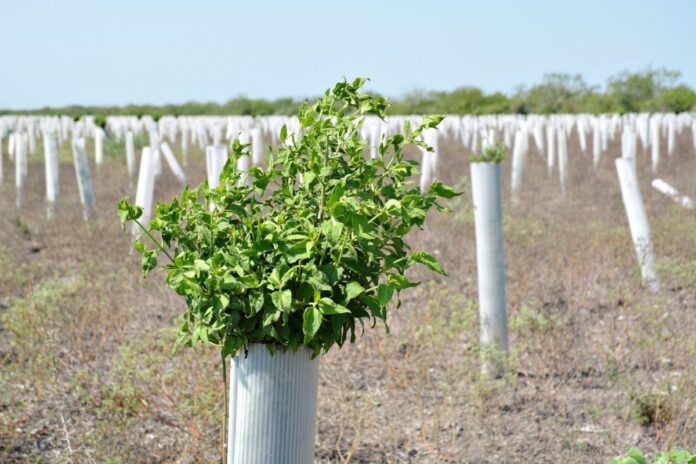HARLINGEN — Buoyed by the phenomenal success of last year’s habitat restoration effort, officials at Laguna Atascosa National Wildlife Refuge are seeking volunteers for another planting of native species at the refuge.
In early 2017, 34 acres were sown on a refuge plot in hopes of accelerating what can be a two-decade wait to fully re-establish native Tamaulipan thorn scrub.
By using an innovative technique of sheltering each seedling in a white plastic sleeve, the experiment showed a 93-percent survival rate for snake eyes, or devil queen, Texas torchwood, crucita or Christmas bush, trixis or American threefold, lantana, Berlandier croton and Manzanita, or Barbados cherry.
Previous habitat restoration plantings in the Rio Grande Valley showed a seedling survival rate of between 20 and 30 percent as white-tailed deer, nilgai, feral hogs, javelina, rats and rabbits mowed down the tender new plants before they had a chance.
Some plots had a success rate of zero.
This year on March 10 between 8 a.m. and noon, volunteers will help U.S. Fish and Wildlife Service workers plant 30,000 seedlings inside the white tubes adjacent to the previous plot to create ocelot-friendly habitat.
“We’re not going to do it all in one day,” said Marion Mason, lead ranger at Laguna Atascosa. “I don’t want to freak people out by thinking they’re going to be overwhelmed.
“Whatever they can do, they don’t have to do the whole four hours, they don’t even have to come at eight,” she added. “They can come any time between 8 and 12 and do as much or as little as they feel able.”
Mason advises that volunteers bring work gloves, shovels, sturdy shoes or boots, water bottles, sunscreen and hats. Water refills and snacks will be provided.
Last year nearly 300 acres in Cameron and Hidalgo counties were planted with native seedlings to restore the Valley’s original thorn scrub habitat. On most of that acreage, however, the tree protectors were not employed.
Restoring native habitat is a huge plus for the endangered Texas subspecies of ocelot on the Laguna Atascosa refuge and elsewhere in South Texas. Restoration of habitat is considered a key component to saving the wildcats, which, unlike their bobcat cousins, are quite fussy when it comes to where they want to live.
“If you come out to the refuge if you come into the main entrance, which is 22688 Buena Vista Road, and then there will be signs directing them to go down to Lakeside Drive and we have a nice big parking lot there,” Mason said. “We’ll have a Porta-John as well.
“It’ll be pretty clear once they get to the refuge on where to go,” she added. “If there are any questions, they can always come into the visitor center and we can direct them.”
WHEN: Saturday, March 10, 8 a.m. to noon
WHERE: Laguna Atascosa National Wildlife Refuge (For the best driving route to the refuge, go online to www.fws.gov/refuge/Laguna_Atascosa)
Bring work gloves, shovel, sturdy shoes or boots, water bottle, sunscreen and hat (water refills and snacks provided).
Groups can RSVP to Ranger Marion Mason by calling 956-748-3607.




